On the Web cam it is clear that Telyn is back. Sleek, powerful and yellow-eyed, the osprey has successfully raised a dynasty high above the wind-buffeted grass near the west Wales coast. Last year came Berthyn, Peris and Hesgyn — they sound like Game of Thrones characters. The watchers are waiting for Telyn’s mate, local hero Monty. A magnificent fisherman, heroic provider and model father, he’s been a fixture at the Dyfi Osprey Project since 2008. But where is he?
“Is Monty back?” says every third post on the Web cam’s chatboard.
He isn’t — instead, there’s a new pretender on the nest, upstart Idris. He’s doing everything right, ingratiating himself with Telyn, bringing offerings of sea trout and twigs, chasing off intruders and yes, mating. Is this the end for the Burton and Taylor of ospreys?
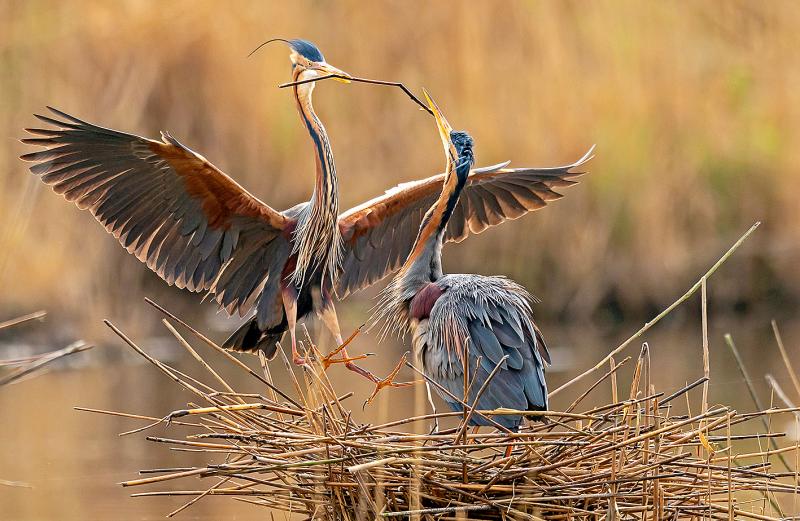
Photo: EPA-EFE/Ronald Wittek
Unswayed by Idris’s can-do attitude and beady-eyed charm, Team Monty is inconsolable.
“Still waiting for Monty? His usual slot is mid-afternoon,” says one hopeful post. “Hope Monty is home tomorrow, he is all I have known since 2011, love you, amber eyes,” says another. Still they wait.
Sex and violence, birth, death and bitter rivalry: welcome to nest-flix.
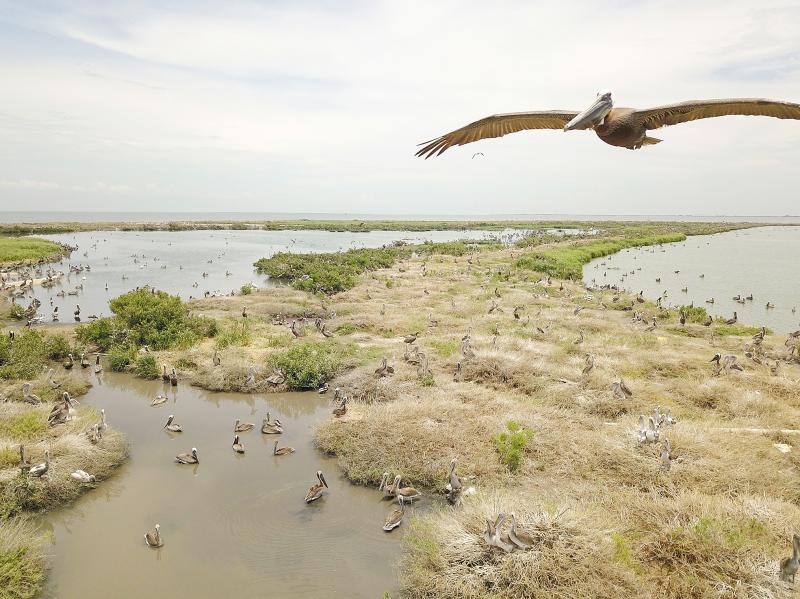
Photo: AP/Louisiana Department of Wildlife and Fisheries
More and more of us are becoming bird voyeurs, tuning into nestcams in the hope of getting a peep at the precarious miracle of new life.
At a time when the world is frightening and our outlook on it has become simultaneously restricted and vertiginously wide, wildlife cams are enjoying unprecedented popularity. They offer connection and continuity — the transporting sensation of watching a creature indifferent to human endeavour going about its life. Edinburgh Zoo has seen a surge of viewers watching its penguins, pandas and koalas, from an average of around 100,000 plays per month to more than 5 million in March this year. One small Hampshire zoo has seen traffic increase by 27,000 percent.
A call-out online reveals people watching the mesmerizing Monterey Bay Aquarium jellyfish, colorful Panamanian bird feeders and Californian penguins. One respondent describes how she and her friends have “developed a deep group attachment” to a hummingbird nestcam.
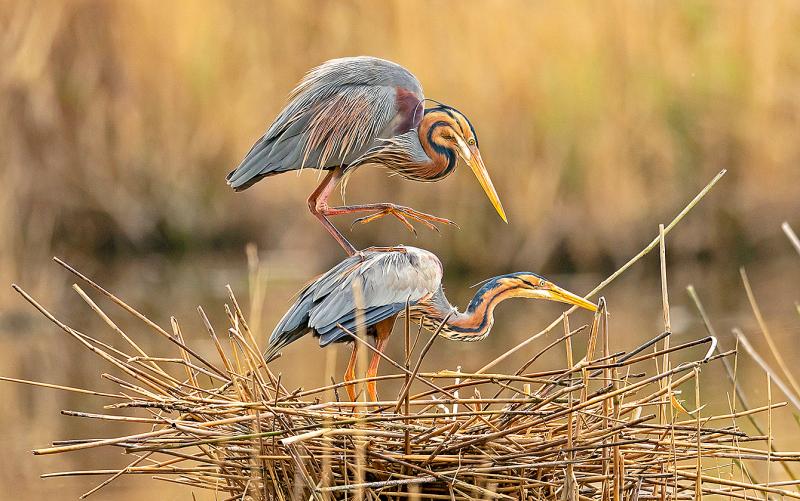
Photo: EPA-EFE
“There’s something very sledgehammer symbolic about it: let us affectionately watch the persistence of tiny, brightly coloured life together.”
PERFECT STORY ARC
Birds may not seem the most exciting of all the wildlife cams at our disposal, but what they offer is the perfect arc, from egg-laying to hatching to fledgling. It makes them a peculiarly gripping watch: viewing figures for the Cornell Lab Bird Cams in the US, broadcasting from as far as New Zealand and Panama, are up 15 percent on last year.
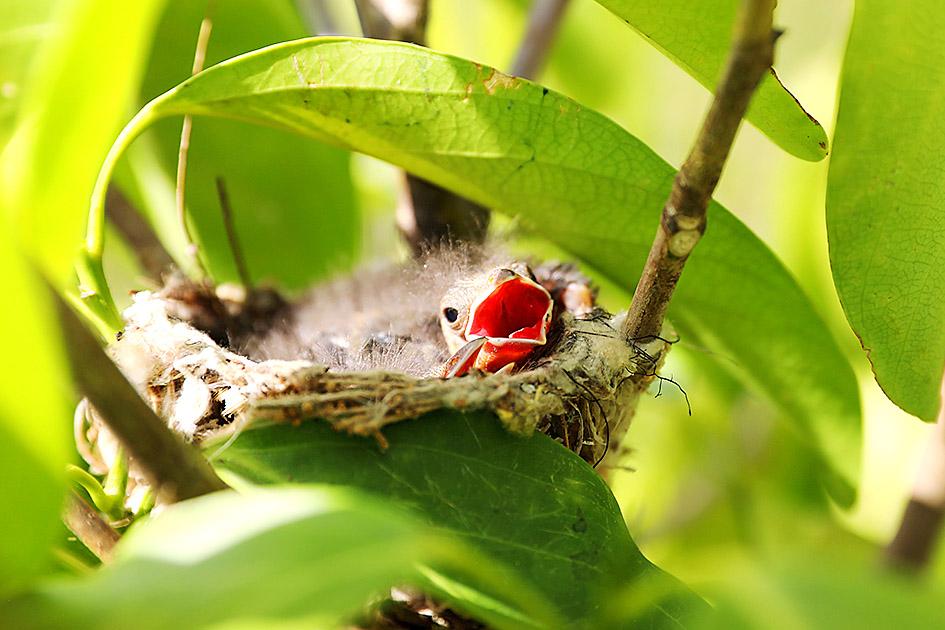
Photo: EPA-EFE
Author Lissa Evans knows something about story-telling. She’s an avid watcher of the unfolding drama at Dyfi.
“Every year that I’ve been watching there is a marvelous narrative,” she says. “The mating, the egg laying, the hatching, the odd drama of ‘strange’ adults turning up at the nest, and then, best of all — the fledging. The adolescents flap their wings and teeter on the edge and nudge each other and lose their nerve and then suddenly one of them goes for it, and they’re off. It’s wonderful and moving.”
Stories, of course, have heroes and villains — Monty vs Idris. Marie Thomas of Salisbury Cathedral, where a pair of peregrines has nested since 2015, describes the dramas that play out there as “like watching Trollope,” though it sounds more Lars von Trier. The set dressing only reinforces that impression — peregrine nests are bleakly exposed boxes of gravel strewn with dismembered pigeon parts. A friend who watched one pair dourly raise four gawky chicks on bloody morsels of birds, nicknamed them “Ted and Sylvia.”
Tricia Glass is one of the cathedral volunteers for whom the peregrine Web cam is a connection to a place they cherish and are currently excluded from. I can hear her excitement as she tells me how Sally, the resident female, found herself without a mate in 2018, then failed to defend her nest against an incoming pair last year, returning in the middle of the night (“May 17, that’s how much I watch them”) to attempt a coup.
“There were some fairly spectacular fights on the tower, absolutely bloodthirsty.”
She’s far from alone: Salisbury’s Web cam drew 6,008 page views in March of last year; this year it was more than 55,000 so far.
But Monty and Sally may not return; not all stories have happy endings.
“It’s not Disney” is a phrase you hear frequently in nestcam circles. Some species lay more eggs than they can successfully raise; fledgling tragedies are commonplace. Famously, in 2014, the Woods Hole osprey cam in the US created online horror when the female began attacking and starving her chicks. Evans recalls watching a clutch of water rail chicks (“little black fluffy balls of loveliness”) on the BBC’s Springwatch as “a snake eased its way into the nest and ate two live on camera, while the other chicks ran away screaming. I have never seen anything more astonishing and horrific.”
TRAGEDY STRIKES
Meanwhile, on Norwich Cathedral’s Web cam, peregrine watchers were devastated in 2017 when an inexperienced mother accidentally hurled one of her chicks off the nest.
Of course we’re horrified when awful things happen: it’s only human.
“When you’re watching something starve to death or be picked apart by a predator, it’s an emotionally powerful situation,” says Charles Eldermire , who manages the Cornell Lab cams. “Even for us — I’m a scientist with decades of work in the field — it’s not easy to watch something dying.”
Perhaps we shouldn’t anthropomorphize animal behavior, but, inevitably, we do. A big part of the communication strategy at Cornell is explaining that (with the exception of some critically endangered species) non-intervention when things go “wrong” is usually the ethical approach, however difficult to watch. It’s also about explaining that upsetting behaviors can be normal and natural.
“There are species for whom living on that edge of failing is part of their history,” Eldermire explains. Cornell’s philosophy is that individual upset can be usefully reframed and refocused on species-level concern and conservation.
“If you feel like these individuals are important and you’re bummed about that cat eating them, we need to think about our own choices and our own governments.”
For others, it’s less a thirst for drama that drives our viewing than a craving for a natural world we can’t currently experience in person.
“Now, more than ever, plenty of people don’t have access to nature,” says Eldermire. The popularity of nestcams “underscores the power that experiencing nature has, even if it’s just through a screen. That we can transmit a slice of it and still have an effect is marvellous, but it’s also something to marvel at.”
For Eldermire part of the appeal is the sense you are experiencing nature firsthand. “You don’t control the binoculars, but there’s a true validity to the experience. You’re not selecting the playlist in Spotify for ‘calm work mode.’”
“Real” birdwatchers might disagree. Richard Smyth is the author of An Indifference of Birds, which explores how the lives of humans and birds intersect (or don’t). He partly agrees with Eldermire.
“The birds don’t know they’re supposed to be performing and there’s no director bellowing, ‘Be magnificent!’”
Despite that, the experience of watching through Web cams seems to him a partly artificial one.
“There’s a school of thought where it’s not an authentic experience if you haven’t taken three days to walk across the Trossachs to find it; that it’s a mediated modern experience that is not truly authentic.”
Smyth does see the value of filmed footage.
“Anyone being sniffy is missing this really obvious point: you’re just not going to see that kind of behavior, that kind of detail in any other way. What other chance have you got to see eggs in a nest, eggs hatching?”
He will happily watch a peregrine cam. The falcon’s resurgence as an urban bird, nesting on church spires and tower blocks after decades of critical endangerment, is an extraordinary success story that features in his book.
“You have to stop and think: ‘Hang on, 30 or 40 years ago this would have seemed absolutely mad.’ Web cams are helping us get in touch with that.”

One of the biggest sore spots in Taiwan’s historical friendship with the US came in 1979 when US president Jimmy Carter broke off formal diplomatic relations with Taiwan’s Republic of China (ROC) government so that the US could establish relations with the People’s Republic of China (PRC). Taiwan’s derecognition came purely at China’s insistence, and the US took the deal. Retired American diplomat John Tkacik, who for almost decade surrounding that schism, from 1974 to 1982, worked in embassies in Taipei and Beijing and at the Taiwan Desk in Washington DC, recently argued in the Taipei Times that “President Carter’s derecognition

This year will go down in the history books. Taiwan faces enormous turmoil and uncertainty in the coming months. Which political parties are in a good position to handle big changes? All of the main parties are beset with challenges. Taking stock, this column examined the Taiwan People’s Party (TPP) (“Huang Kuo-chang’s choking the life out of the TPP,” May 28, page 12), the Democratic Progressive Party (DPP) (“Challenges amid choppy waters for the DPP,” June 14, page 12) and the Chinese Nationalist Party (KMT) (“KMT struggles to seize opportunities as ‘interesting times’ loom,” June 20, page 11). Times like these can
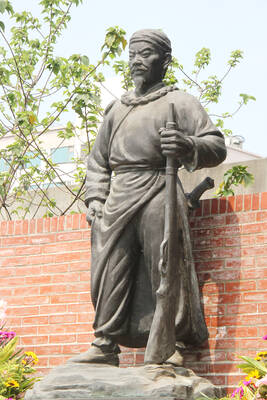
JUNE 30 to JULY 6 After being routed by the Japanese in the bloody battle of Baguashan (八卦山), Hsu Hsiang (徐驤) and a handful of surviving Hakka fighters sped toward Tainan. There, he would meet with Liu Yung-fu (劉永福), leader of the Black Flag Army who had assumed control of the resisting Republic of Formosa after its president and vice-president fled to China. Hsu, who had been fighting non-stop for over two months from Taoyuan to Changhua, was reportedly injured and exhausted. As the story goes, Liu advised that Hsu take shelter in China to recover and regroup, but Hsu steadfastly

You can tell a lot about a generation from the contents of their cool box: nowadays the barbecue ice bucket is likely to be filled with hard seltzers, non-alcoholic beers and fluorescent BuzzBallz — a particular favorite among Gen Z. Two decades ago, it was WKD, Bacardi Breezers and the odd Smirnoff Ice bobbing in a puddle of melted ice. And while nostalgia may have brought back some alcopops, the new wave of ready-to-drink (RTD) options look and taste noticeably different. It is not just the drinks that have changed, but drinking habits too, driven in part by more health-conscious consumers and